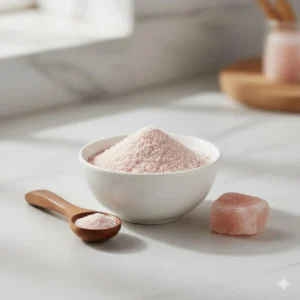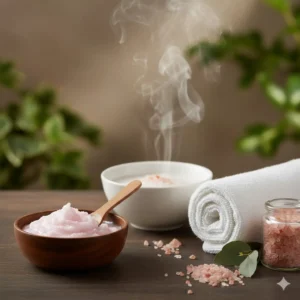Saindhava Lavana, commonly known as Himalayan salt, is a naturally occurring mineral long esteemed in Ayurveda for its ability to maintain internal balance and overall wellness. Distinguished by its subtle pink hue and rich mineral composition, it is prized for harmonizing all three doshas—Vata, Pitta, and Kapha—while supporting digestion, skin vitality, and respiratory health. This article explains how to use Himalayan salt safely and effectively within Ayurvedic practices to promote daily harmony and holistic well-being.
Prerequisites: Tools and Materials

Before incorporating Saindhava Lavana into Ayurvedic routines, ensure you have the appropriate tools and natural ingredients ready. These essentials enable accurate preparation, maintain hygiene, and preserve the salt’s therapeutic value for both internal and external applications.
| Item | Purpose | Notes |
|---|---|---|
| Authentic Himalayan Salt Block or Pink Salt | Primary ingredient for Ayurvedic use | Select natural, high-purity salt free from additives or processing |
| Measuring Spoon or Scale | Ensures accurate portioning | Essential for maintaining proper dosage |
| Warm Water or Mustard Oil | Serves as a medium for application or ingestion | Use according to the type of Ayurvedic preparation |
| Clean Container or Bowl | Used for mixing and preparation | Opt for glass or ceramic to prevent contamination |
| Soft Cloth or Scrub Brush | Facilitates external salt applications | Use a gentle texture suitable for exfoliation |
Having these materials in place ensures every preparation with Saindhava Lavana—whether for digestion, detoxification, or skin care—remains effective, clean, and precisely balanced.
Step-by-Step Guide to Using Saindhava Lavana in Ayurveda
Himalayan salt, or Saindhava Lavana, has a long-standing role in Ayurveda for its harmonizing influence on all three doshas—Vata, Pitta, and Kapha. The following steps outline safe, effective ways to integrate this mineral-rich salt into daily routines to support wellness and holistic health.
Step 1: Choose and Prepare Authentic Himalayan Salt
Start by confirming that the salt you use is authentic and unrefined. Genuine Himalayan salt displays a natural pink tone that reflects its mineral composition. Refined or bleached versions diminish its Ayurvedic value and may disturb dosha balance.
- Source pure pink Himalayan salt from trusted suppliers that certify authenticity and absence of additives.
- Grind or crush the salt to the desired coarseness, depending on whether it is used for cooking or topical treatments.
- Store it in a dry, tightly sealed container to maintain mineral integrity and prevent moisture absorption.
Step 2: Incorporate Saindhava Lavana into Diet and Remedies

Ayurveda recognizes Saindhava Lavana as both a culinary and therapeutic ingredient. Its mild, balanced nature allows daily use when measured appropriately. Inclusion in foods or remedies can support digestion and maintain overall equilibrium.
- Add a small pinch to meals to enhance flavor and promote digestive comfort without disrupting dosha balance.
- Prepare sole water by dissolving a minimal amount of salt in warm water under guidance from an Ayurvedic practitioner.
- Use it in herbal oils or decoctions designed for cleansing or rejuvenation therapies.
Step 3: Use Externally for Skin and Respiratory Support

External application of Saindhava Lavana complements internal use by refining skin texture and aiding respiratory clarity. Its mild exfoliating and soothing properties help renew the skin and open breathing channels.
- Create a gentle scrub by combining fine salt with sesame or coconut oil to exfoliate and nourish the skin.
- For respiratory ease, inhale steam infused with a light saline solution to help relieve congestion.
- Apply a warm salt compress on stiff or swollen joints to ease discomfort related to Vata imbalance.
Step 4: Sustain Dosha Harmony through Mindful Use
Himalayan salt’s ability to balance all three doshas defines its unique Ayurvedic value. Consistent moderation preserves this balance, while overuse—like with any salt—can disrupt natural harmony.
- Leverage its light and cooling attributes to soothe excess Pitta and Vata while supporting Kapha regulation in the respiratory system.
- Follow professional dosage guidance to prevent excessive sodium intake or imbalance.
- Integrate use with appropriate diet and lifestyle adjustments to reinforce long-term vitality and internal balance.
Premium Himalayan salt blocks for Culinary & Hospitality Use
Enhance your culinary and wellness programs with authentic Himalayan salt blocks sustainably sourced from the Himalayan region. Jilin Ever Creation provides Saindhava Lavana products renowned for purity and balanced mineral content—ideal for Ayurveda-inspired dining, spa treatments, and holistic hospitality offerings. Options include custom sizing, packaging, and global supply solutions.

Ayurvedic Benefits of Saindhava Lavana

In Ayurveda, Himalayan salt—known as Saindhava Lavana—is regarded as the only salt capable of balancing all three doshas: Vata, Pitta, and Kapha. This rare quality makes it suitable for most body constitutions, promoting internal harmony and overall wellness. Its gentle character allows for regular use without disturbing the body’s natural equilibrium.
Among its principal benefits is digestive support. Saindhava Lavana helps stimulate digestive enzymes, enhances nutrient absorption, and eases bloating without irritating the stomach lining. It also aids respiratory health through halotherapy, where its mineral-rich microparticles help clear mucus, ease breathing, and reduce mild inflammation.
For skin care, its fine mineral composition provides mild exfoliation that refines texture and restores radiance. Used in scrubs or baths, it helps keep pores clear and supports the skin’s natural tone. Its electrolytes further contribute to balanced hydration, prevent muscle cramps, and help maintain optimal fluid distribution throughout the body.
Overall, Saindhava Lavana exemplifies Ayurveda’s integrative approach to health—nurturing digestion, respiration, and skin vitality while sustaining inner balance through a single, naturally harmonizing mineral source.
Common Mistakes and How to Avoid Them
In Ayurveda, Saindhava Lavana—Himalayan salt—is valued for its ability to harmonize the three doshas: Vata, Pitta, and Kapha. However, a few common missteps can reduce its benefits or lead to discomfort if overlooked. Understanding these points helps ensure safe, effective, and consistent results in Ayurvedic wellness practices.
| Common Mistake | Solution / How to Avoid |
|---|---|
| Using excessive amounts daily | Measure portions carefully to avoid dosha imbalance and excess sodium intake. Moderate, mindful use supports balance and digestion. |
| Confusing table salt with Saindhava Lavana | Always select genuine Himalayan salt from reputable sources to ensure mineral integrity and preserve Ayurvedic properties. |
| Applying salt scrubs on broken or sensitive skin | Do not exfoliate irritated or damaged skin. Conduct a patch test before wider use to confirm skin tolerance. |
| Relying solely on salt for respiratory support | Use halotherapy or salt inhalation as complementary measures, and consult a qualified practitioner for ongoing respiratory issues. |
| Storing salt in humid or unclean conditions | Keep Himalayan salt dry and sealed to preserve its mineral quality, taste, and therapeutic effectiveness over time. |
Using Saindhava Lavana with care protects its purity and maximizes its wellness potential. Proper handling, moderation, and storage allow this natural mineral to fully support balance, vitality, and holistic health.
Frequently Asked Questions
What does “Saindhava Lavana” mean in the Ayurvedic context?
In Ayurveda, Saindhava Lavana refers to Himalayan rock salt, a naturally occurring mineral formed deep within the Himalayan Mountains. Ancient Ayurvedic texts describe it as the most superior type of salt—valued for its purity, balanced flavor, and therapeutic suitability for daily use.
How does Himalayan salt differ from common table salt in Ayurveda?
Ayurveda considers Himalayan salt more natural and balanced than refined table salt. Unlike processed salt, it retains essential trace minerals and contains no chemical additives, making it gentle on digestion and supportive of internal balance without aggravating any dosha.
Is Himalayan pink salt considered cooling or heating according to Ayurveda?
Saindhava Lavana is regarded as mildly cooling in Ayurvedic tradition. This quality helps calm excess Pitta while supporting healthy circulation and metabolism, making it a gentle choice for those prone to heat or acidity.
How does Saindhava Lavana help balance the three doshas—Vata, Pitta, and Kapha?
Himalayan salt is considered the only salt that supports equilibrium among Vata, Pitta, and Kapha. It nourishes without causing overheating or dryness, regulates water balance, and harmonizes internal energy flow, making it appropriate for most body constitutions.
Is Saindhava Lavana the same as the “sole water” practice popular in wellness communities?
The “sole water” method, which uses Himalayan salt dissolved in water, originates from Ayurvedic cleansing traditions. While modern interpretations focus on hydration and mineral intake, the Ayurvedic approach emphasizes balancing doshas and supporting natural detoxification through mindful, moderate use.
Final Thoughts
Integrating Saindhava Lavana into daily routines can enhance digestion, support respiratory clarity, nurture the skin, and promote dosha balance. When selected and applied with care, it becomes more than a mineral remedy—it serves as a natural, enduring support for physical and mental harmony.
Authentic Himalayan salt represents the essence of Ayurvedic wisdom, where pure elements work in alignment with human well-being. Its mindful use bridges modern wellness practices with ancient principles that value moderation and awareness.
As your Ayurvedic practice deepens, consider complementary therapies suited to your constitution. Consistent, respectful use of Saindhava Lavana encourages lasting vitality, clarity, and holistic balance.






